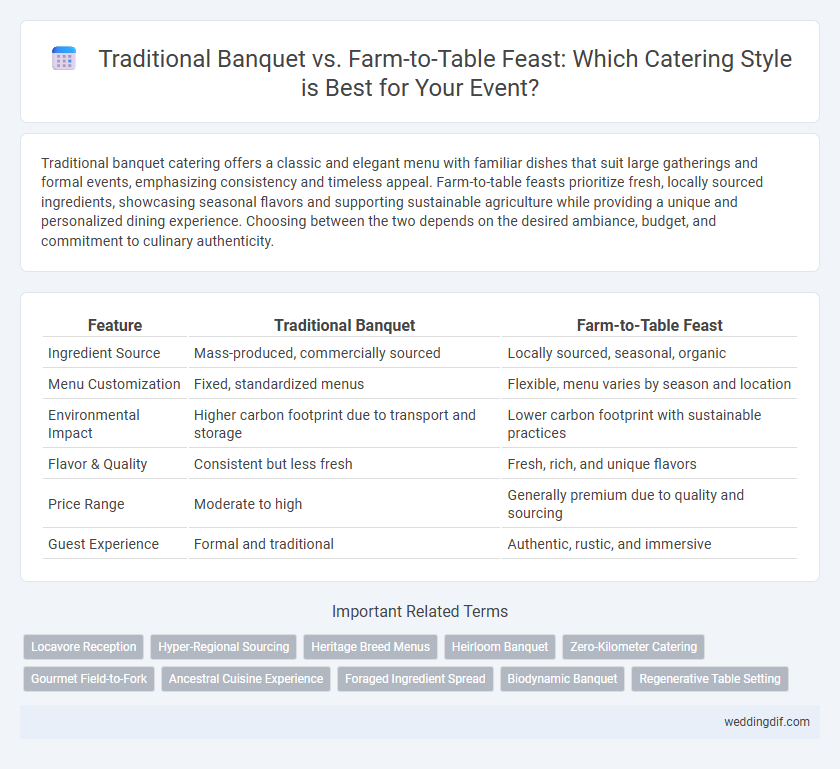Traditional banquet catering offers a classic and elegant menu with familiar dishes that suit large gatherings and formal events, emphasizing consistency and timeless appeal. Farm-to-table feasts prioritize fresh, locally sourced ingredients, showcasing seasonal flavors and supporting sustainable agriculture while providing a unique and personalized dining experience. Choosing between the two depends on the desired ambiance, budget, and commitment to culinary authenticity.
Table of Comparison
| Feature | Traditional Banquet | Farm-to-Table Feast |
|---|---|---|
| Ingredient Source | Mass-produced, commercially sourced | Locally sourced, seasonal, organic |
| Menu Customization | Fixed, standardized menus | Flexible, menu varies by season and location |
| Environmental Impact | Higher carbon footprint due to transport and storage | Lower carbon footprint with sustainable practices |
| Flavor & Quality | Consistent but less fresh | Fresh, rich, and unique flavors |
| Price Range | Moderate to high | Generally premium due to quality and sourcing |
| Guest Experience | Formal and traditional | Authentic, rustic, and immersive |
Introduction: Defining Traditional Banquet and Farm-to-Table Feast
Traditional banquet catering emphasizes classic, timeless dishes often featuring rich, elaborate courses prepared with standardized recipes and presentation styles. Farm-to-table feasts prioritize sourcing fresh, locally grown ingredients directly from farms, highlighting seasonal produce and sustainable practices. Both approaches deliver unique culinary experiences tailored to event themes and client preferences.
Culinary Philosophy: Classic Elegance vs Fresh Local Flavors
Traditional banquet catering emphasizes classic elegance through meticulously prepared dishes rooted in time-honored recipes and formal presentation. Farm-to-table feasts highlight fresh local flavors by sourcing seasonal ingredients directly from nearby farms, promoting sustainability and vibrant taste profiles. Choosing between the two depends on the desired culinary philosophy: refined tradition versus contemporary freshness and environmental consciousness.
Menu Variety: Time-Honored Dishes or Seasonal Selections
Traditional banquet menus emphasize time-honored dishes that showcase classic culinary techniques and cherished recipes passed down through generations. Farm-to-table feasts prioritize seasonal selections sourced from local farms, highlighting fresh, sustainable ingredients that reflect the current harvest. Both approaches offer distinct menu variety tailored to cultural nostalgia or ingredient freshness, catering to diverse client preferences.
Ingredient Sourcing: Mass Market vs Local Farms
Traditional banquet catering typically relies on mass-market ingredient sourcing, focusing on bulk purchasing from large suppliers to ensure consistency and cost-efficiency. In contrast, farm-to-table feasts prioritize fresh, locally-sourced ingredients directly from nearby farms, emphasizing seasonal flavors and sustainability. This distinction impacts menu quality, environmental footprint, and the overall dining experience, with farm-to-table catering offering a more authentic and eco-conscious alternative.
Guest Experience: Formal Atmosphere or Rustic Charm
Traditional banquet catering offers a formal atmosphere with elegant table settings, structured service, and classic menu options, creating a sophisticated guest experience ideal for weddings and corporate events. In contrast, farm-to-table feasts emphasize rustic charm through locally sourced, seasonal ingredients and communal dining, fostering a warm, relaxed environment that highlights sustainability and culinary authenticity. Choosing between these styles depends on the desired ambiance, with traditional banquets providing refinement and farm-to-table catering delivering an intimate, nature-inspired experience.
Presentation Styles: Plated Service vs Family-Style Feasts
Plated service in traditional banquets emphasizes elegance and control, featuring individually plated dishes that highlight intricate presentation and portion precision. Family-style feasts in farm-to-table catering foster a communal atmosphere, showcasing rustic, artistically arranged platters that emphasize fresh, seasonal ingredients and shared dining experiences. Each style influences guest interaction and ambiance, with plated service prioritizing formality and farm-to-table focusing on warmth and natural aesthetics.
Environmental Impact: Sustainability in Wedding Catering
Traditional banquets often generate significant food waste and rely on imported ingredients, increasing carbon footprints and resource consumption. Farm-to-table feasts prioritize locally sourced, seasonal produce, reducing transportation emissions and supporting sustainable farming practices. Emphasizing environmental impact, farm-to-table catering offers a greener, more eco-conscious choice for weddings committed to sustainability.
Cost Considerations: Budgeting for Banquet or Farm-to-Table
Traditional banquets typically offer predictable food costs due to bulk purchasing and standardized menus, making budgeting straightforward for large events. Farm-to-table feasts often involve higher expenses driven by sourcing seasonal, locally grown ingredients and supporting small-scale farmers, which can increase per-plate prices. Event planners must weigh the consistency and cost savings of traditional catering against the premium quality and sustainability appeal of farm-to-table menus when allocating budgets.
Customization Options: Personalizing Your Wedding Menu
Traditional banquets offer structured, classic menus with limited customization, often featuring fixed courses and standardized dishes that align with cultural or regional norms. Farm-to-table feasts provide extensive customization options by incorporating seasonal, locally sourced ingredients, allowing couples to tailor their wedding menu to reflect their tastes and dietary preferences while supporting sustainable practices. Personalizing your wedding menu through farm-to-table catering enhances guest experience with fresh, unique flavors tailored to your story and venue.
Decision Guide: Choosing the Right Catering Style for Your Big Day
Selecting between a traditional banquet and a farm-to-table feast hinges on event goals, guest preferences, and budget constraints. Traditional banquets offer structured multi-course meals with classic flavors, ideal for formal occasions seeking elegance and consistency. Farm-to-table feasts emphasize local, seasonal ingredients, promoting sustainability and personalized menus that cater to eco-conscious guests and create a unique dining experience.
Traditional Banquet vs Farm-to-Table Feast for Catering Infographic

 weddingdif.com
weddingdif.com